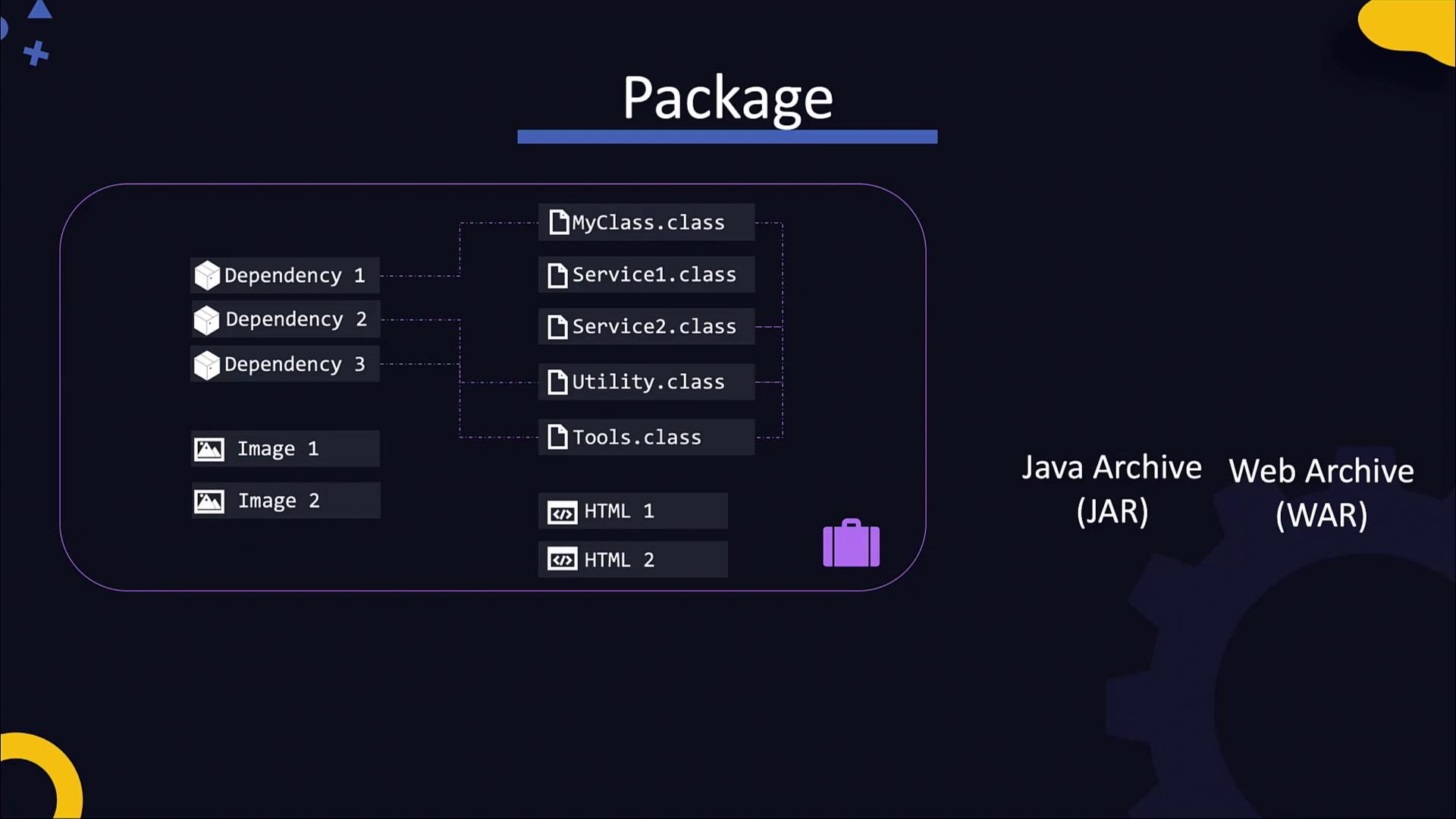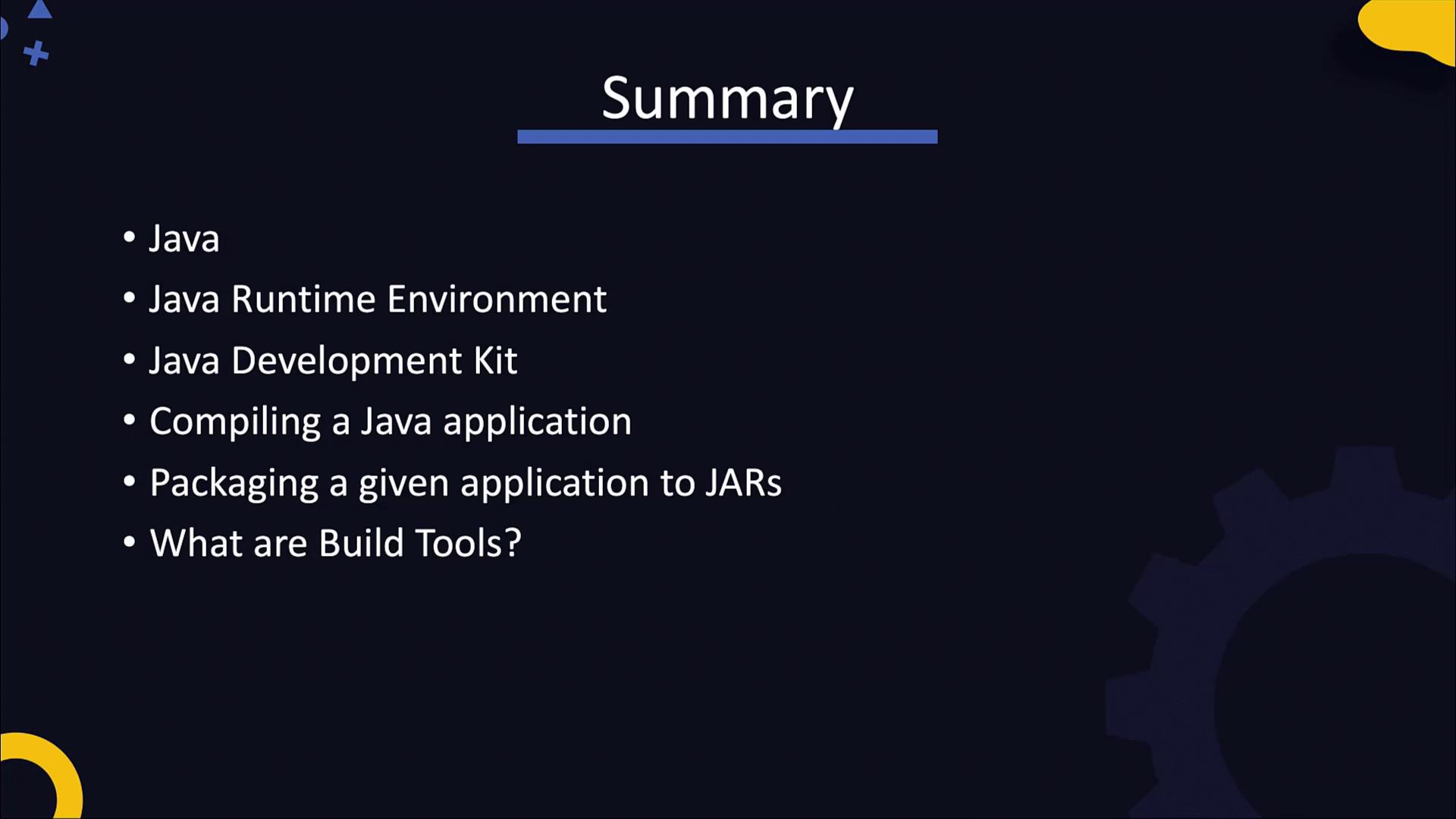DevOps Pre-Requisite Course
Applications Basics
Java Build Packaging
In this guide, we explore the process of building a Java application—from writing and compiling source code to packaging it into a distributable format and generating documentation. We will also demonstrate how build tools automate these processes. The following sections outline a straightforward build process and then discuss more complex workflows using tools such as Ant, Maven, and Gradle.
Compiling a Simple Java Application
A basic Java application follows these steps:
- Write the source code.
- Compile the code into bytecode.
- Run the compiled code using the Java Virtual Machine (JVM).
Consider the source file, MyClass.java:
public class MyClass {
public static void main(String[] args) {
System.out.println("Hello World");
}
}
To compile this file, run:
javac MyClass.java
This command produces a bytecode file named MyClass.class. To execute the application, use:
java MyClass
The output will be:
Hello World
Java source code is transformed into bytecode via the compilation process. The JVM then executes these low-level instructions. You might also inspect the bytecode instructions, as shown below:
0: iconst_2
1: istore_1
2: iload_1
3: sipush 1000
6: if_icmpge 44
9: iconst_2
10: istore_2
11: iload_2
12: iload_1
13: if_icmpge 31
This sequence represents instructions that enable Java applications to remain cross-platform. As long as a system has a compatible JVM, compiled code can run anywhere.
Packaging the Application
Complex applications often include multiple class files along with external dependencies and resources. For distribution, these files are packaged into an archive file. Typically, applications are packaged into a JAR (Java Archive) file, while web applications might be packaged into a WAR (Web Archive) file containing static assets like HTML, images, and CSS.
To package the application into a JAR file, run:
jar cf MyApp.jar MyClass.class Service1.class Service2.class ...
This command creates the MyApp.jar file and automatically generates a manifest file at META-INF/manifest.mf with metadata about the package. The manifest can also specify the application’s entry point using the Main-Class attribute.
To execute the JAR file directly, use:
java -jar MyApp.jar
This will produce the familiar output:
Hello World
Generating Documentation
Documenting your Java code using Javadoc is a best practice that generates an HTML API documentation site. To create the documentation, run:
javadoc -d doc MyClass.java
This command creates a directory (doc) with a complete HTML documentation site that other developers can easily navigate.
Tip
Using Javadoc ensures that your code documentation remains up-to-date and accessible, which is vital for collaborative development.
The Build Process Overview
The essential build process for a Java application can be summarized in the following commands:
javac MyClass.java
jar cf MyClass.jar [list of classes and resources]
javadoc -d doc MyClass.java
For small projects, performing these steps manually works well. However, as projects grow with more files, dependencies, and team members, automating these tasks becomes necessary.
Automating Builds with Ant
Ant is a popular build tool that uses an XML configuration file to define various build targets such as compile, document, and package. Below is an example of an Ant build script (build.xml):

<?xml version="1.0"?>
<project name="Ant" default="main" basedir=".">
<!-- Compiles the Java code -->
<target name="compile">
<javac srcdir="/app/src" destdir="/app/build">
</javac>
</target>
<!-- Generates Javadoc -->
<target name="docs" depends="compile">
<javadoc packagenames="src" sourcepath="/app/src" destdir="/app/docs">
<fileset dir="/app/src">
<include name="**/*" />
</fileset>
</javadoc>
</target>
<!-- Creates the deployable JAR file -->
<target name="jar" depends="compile">
<jar basedir="/app/build" destfile="/app/dist/MyClass.jar">
<manifest>
<attribute name="Main-Class" value="MyClass" />
</manifest>
</jar>
</target>
<!-- Main target that assembles the project -->
<target name="main" depends="compile, jar, docs">
<description>Main target</description>
</target>
</project>
To execute specific targets, such as compiling and packaging without generating documentation, run:
ant compile jar
Quick Tip
Using Ant targets enables you to selectively run just the portions of the build process you need.
Build Tools in the Java Ecosystem
Modern Java projects use build tools like Maven, Gradle, or Ant to simplify the build process by using configuration files. Below are details on Maven and Gradle.
Maven
Maven uses a file called pom.xml to define the project’s build logic, dependencies, and plugins. Here is an example configuration:
<?xml version="1.0" encoding="UTF-8"?>
<project xmlns="http://maven.apache.org/POM/4.0.0"
xmlns:xsi="http://www.w3.org/2001/XMLSchema-instance"
xsi:schemaLocation="http://maven.apache.org/POM/4.0.0 http://maven.apache.org/xsd/maven-4.0.0.xsd">
<modelVersion>4.0.0</modelVersion>
<groupId>com.shopizer</groupId>
<artifactId>shopizer</artifactId>
<version>2.9.0</version>
<packaging>pom</packaging>
<name>shopizer</name>
<url>http://maven.apache.org/</url>
<licenses>
<license>
<name>Apache License, Version 2.0</name>
<url>https://www.apache.org/licenses/LICENSE-2.0.txt</url>
</license>
</licenses>
</project>
To build a Maven project, use the following commands:
$ git clone git://github.com/shopizer-ecommerce/shopizer.git
$ cd shopizer
$ mvn clean install
Gradle
Gradle is another robust build automation tool that often uses a Gradle wrapper for simplified usage. Here is an example Gradle configuration snippet that includes the Docker plugin:
buildscript {
repositories {
jcenter()
}
dependencies {
classpath 'com.bmuschko:gradle-docker-plugin:3.0.6'
}
}
apply plugin: 'java'
apply plugin: 'application'
apply plugin: 'com.bmuschko.docker-java-application'
import com.bmuschko.gradle.docker.tasks.container.*
import com.bmuschko.gradle.docker.tasks.image.*
To build and run your Gradle project, execute:
./gradlew build
./gradlew run
This approach automates multiple steps of the build process, reducing the need for manual commands.
Summary

In summary, this guide covered the fundamentals of building a Java application. We walked through writing source code, compiling it into bytecode, and packaging it into a JAR file with metadata. We also demonstrated how to generate documentation using Javadoc and highlighted the advantages of automating builds with tools like Ant, Maven, and Gradle.
Final Note
Understanding these build processes is an essential step toward mastering advanced DevOps practices, such as continuous integration and containerization.
Happy coding, and be sure to experiment with these build processes in your development environment!
Watch Video
Watch video content
Practice Lab
Practice lab